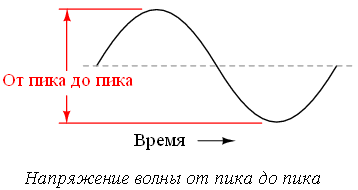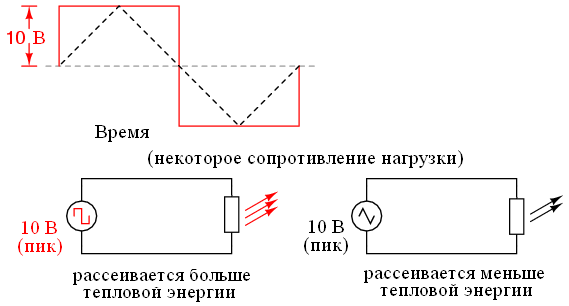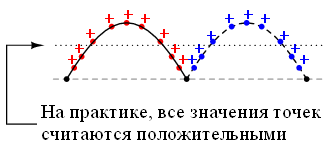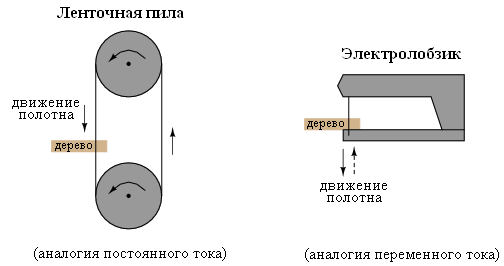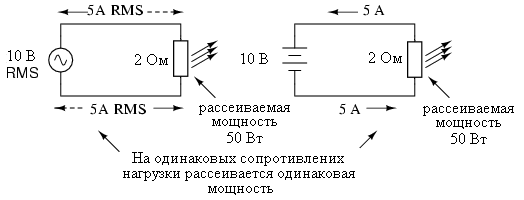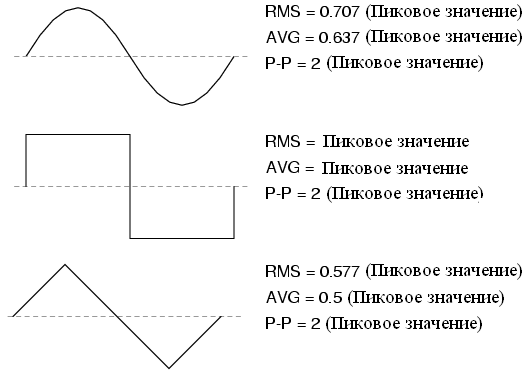Sections of the site
Editor's Choice:
- How to unlock ariston washing machine
- Pros and cons of LED lighting
- Pulse relay: device and connection
- How to calculate the illumination of a room with LED lamps?
- Plastic box - do-it-yourself aesthetic view of electrical wiring
- Electricity consumption of a warm floor: electric and film
- Installing a pump in a well: how to properly install pumping equipment
- Electrician Toolkit Overview
- How to choose a water heater: the most complete list of evaluation criteria
- 1 acoustics on the example of Sven SPS-860 and Realtek ALC889 codec
Advertising
| 3. Measurement of alternating currents |
|
Measurement of alternating currents You already know that alternating voltage alternates its polarity, and alternating current alternates its direction. You also know that by tracking alternating current directions (AC voltage polarities) over time, you can build a "wave" graph. You can also calculate the speed of these alternations (frequency) by determining the time of one period of the wave. However, you still do not know how to determine the magnitude of alternating current or voltage. When working with direct current (voltage), such problems do not arise, since its value is stable. So, how can you measure such a quantity that is constantly changing? One way to solve this problem is to measure the height of the peak on the waveform (see figure below): Another way is to measure the total height between opposite peaks (peak to peak):
Unfortunately, both of these methods can be misleading when comparing two different types of waves. For example, square wave with a peak of 10 volts will keep this tension for more time than triangular wave with the same peak 10 volts. The impact of these two voltages per load will be different (see picture below):
One way expressing the amplitude of various waveforms is the mathematical averaging of the values of all the points on the graph into a single, common value. Such a measure is known as the wave average. If all wave points are averaged algebraically (i.e., take into account their sign, positive or negative), then the average value for most waves will be equal to zero, since the positive points of the full cycle compensate for the negative ones (see the figure below):
This will of course be true for any waveform that has equal parts above and below the zero line of the graph. However, in practice, the average value of a wave is defined as the mathematical average of all points in its cycle. In other words, the average value is calculated taking into account the fact that the points in the set have positive values (see the figure below):
Polarity insensitive pointer meters (responding equally to positive and negative half-cycles of AC/voltage) will record the practical average value of the wave since the inertia of the pointer (caused by spring tension) will record the average force produced by different values of current/voltage over time. Conversely, polarity sensitive pointer gauges will "vibrate" under AC current/voltage, their pointer will oscillate rapidly around zero indicating the true (algebraic) average of a symmetrical wave. The "average" value of the wave, mentioned later in this article, we will correlate with the "practical" average value, unless otherwise indicated. Another way to obtain the overall value of the wave amplitude is based on the ability of this wave to perform useful work on the load resistance. Unfortunately, such an AC current/voltage measurement will differ from the "average" value of the waveform, since power dissipated at a given load(work done per unit of time) Not directly proportional voltage value or current. Power will be proportional voltage squared or current supplied to resistance (P = E 2 / R, and P = I 2 R). Let's take a look at the band saw and jigsaw, two types of modern woodworking equipment. Both types of saws have thin toothed blades driven by electric motors. However, a band saw uses a continuous motion of the blade, while a jigsaw uses a reciprocating motion. Comparing AC to DC can be likened to comparing these two types of saws:
The problem of describing the magnitude of the variable component is also present in this analogy: how can we express the speed of movement of the jigsaw blade? The band saw blade moves at a constant speed, which is equivalent to a constant voltage, the magnitude of which is always the same. The blade of the jigsaw moves back and forth, and the speed of its movement is constantly changing. Moreover, the reciprocating motion of two jigsaws of different designs cannot be the same. The movement of the blade of one jigsaw can be described by the shape of a sine wave, while the movement of the blade of another jigsaw can be described by the shape of a triangular wave. It is incorrect to estimate the speed of movement of the jigsaw blade by peak values; for different types of jigsaws, these values will be different. Notwithstanding the foregoing, all types of saws do the same job (cutting wood), and a quantitative comparison of this common function can serve as a basis for estimating their blade speed. Let's imagine that there are two saws next to each other: one is a band saw, and the other is a jigsaw. Both of these saws have the same blades (same tooth pitch, angle, etc.) and are equally (at the same speed) capable of cutting the same type of wood and the same thickness. In this case, we can say that these saws are equivalent, and their cutting abilities (work performed) are equal. Can this comparison be used to express the reciprocating speed of a jigsaw blade in terms of the rotational speed of a bandsaw blade? Of course you can! The same idea is used to "assign" a DC equivalent (voltage) to the measured AC current (voltage): the same values of DC and AC current (voltage) will produce the same amount of heat on the same resistance (see figure below):
Both of these circuits have the same load resistances (2 ohms) that dissipate the same amount of power (50 watts) as heat. However, the first circuit is powered by an AC voltage source, and the second circuit is powered by a DC voltage source. Since the AC source is equivalent (in terms of power delivered to the load) to a 10 volt DC battery, we will refer to it as a "10 volt" AC source. For greater clarity, we will denote its value as 10 Volts. RMS. The abbreviation RMS stands for " Root Mean Square" or " RMS value". The algorithm for calculating the RMS value is simple: each data value within a predetermined period (usually one cycle) is multiplied by itself (squaring), and then all such values during the period are averaged (summed up and then divided by the total) and the square root is taken from the resulting value. The RMS measurement is used in the vast majority of cases when working with electricity (it is the best way to relate the value of AC voltage / current to the value of DC voltage / current, or to other AC voltage / current values \u200b\u200bthat have different waveforms). But, in some cases it is better to use peak-to-peak measurements. For example, at determining the necessary size wire and for supplying electricity from a power source to a load, it is better to use an RMS current measurement, since our main concern will be the possible overheating of the wire, which is a function of power dissipation when current passes through the resistance of the wire. However, when evaluating the insulation of high voltage wires, it is best to use peak-to-peak measurements, since the main concern in this case is the possible "breakdown" of the insulation precisely by the peak values. Peak or peak-to-peak measurements are best done with an oscilloscope, which can capture the "crests" of the waveform with a high degree of accuracy due to the cathode ray tube's rapid response to voltage changes. RMS measurements can be made with analog meters (d'Arsonval/Weston galvanometers, electromagnetic meters, electrodynamic meters) if they are calibrated in RMS numbers. Because the mechanical inertia and damping effect of electromechanical meters produce pointer deflection proportional to the average AC current/voltage (rather than RMS), an analog instrument must be specifically calibrated to indicate voltage or current in RMS units. The accuracy of this calibration depends on the intended waveform, usually a sine wave. The best way to measure RMS values is with specially designed electronic meters. Some instrument manufacturers developed original methods to determine the RMS value of any form waves. They make "True-RMS" class instruments which contain a tiny resistive heating element powered by a voltage proportional to the voltage being measured. The thermal effect of a given element is measured thermally , and gives the true meaning RMS. Mathematical calculations are not made here at all, everything is based on the laws of physics. The accuracy of such measuring instruments does not depend on the waveform. For symmetrical waveforms, there are simple conversion factors between the following types of values: peak, peak-to-peak (Peak-to-Peak or R-R), practical average (Average or AVG) and rms ( RMS):
In addition to the AC current/voltage values listed above, there are also values expressing proportionality between some of these fundamental measurements. crest factor AC waves, For example, is the ratio of the maximum (peak) current/voltage value to its root mean square (RMS) value. Form factor AC/Voltage waveform is the ratio of the Root Mean Square (RMS) value to its practical average value. The crest factor and form factor of a square wave are always 1, since the peak value of this wave is equal to the RMS and AVG values. The sine wave has an RMS value of 0.707 and a form factor of 1.11 (0.707/0.636). The triangle wave has an RMS value of 0.577 and a form factor of 1.15 (0.577/0.5). Keep in mind that all the above transformations apply only to symmetrical (correct) waveforms. RMS and mean distorted waveforms are not related the same ratios:
This is very important concept to understand. If you are using an analog meter that is calibrated to sinusoidal RMS values, it will only be accurate when measuring a "pure" sine wave. When measuring other types of waves, it will not give you a true RMS value. Since the sinusoidal waveform is the most common in electrical measurements, it is under it that the vast majority of analog measuring instruments are calibrated. Please note that this limitation applies only to simple analog instruments, and does not apply in any way to instruments with “True-RMS” technology. |
New
- Rye malt and what can be done with it?
- How to make fortified wine at home
- How to speed up the fermentation process of homemade wine
- How to make wine yeast at home, instructions for use
- Unfiltered beer - a source of good mood and nutrients Wheat or barley beer
- Intoxicated sweets: seven recipes for berry tinctures
- Dessert wines: names
- Diesel heating boilers for a private house
- Analysis "in a bad society" Korolenko In a bad society reduction
- Fuel consumption of diesel heating boiler

